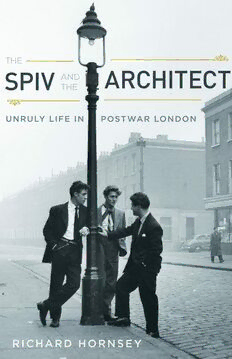
The Spiv and the Architect: Unruly Life in Postwar London PDF
Preview The Spiv and the Architect: Unruly Life in Postwar London
THE- - - - ARCHITECT <>,=;�--- ........... UNRULYL IFEI N POSTWARL ONDON the spiv and the architect This page intentionally left blank the spiv and the architect Unruly Life in Postwar London richard hornsey university of minnesota press minneapolis london • An earlier version of chapter 1was published as “‘Everything Is Made of Atoms’: The Reprogramming of Space and Time in Post-War London,” Journal of Historical Geography 34, no. 1(2008):94–117; copyright 2008; reprinted with permission from Elsevier Ltd. An earlier version of chapter 2was published as “The Queer (Spatial) Economies of The Lavender Hill Mob,”Journal of British Cinema and Television5, no. 1(2008):38–52; reprinted by permission of Edinburgh University Press, http://www.euppublishing.com/journal/jbctv. An earlier version of chapter 3was published as “Francis Bacon at the Photobooth: Facing the Homosexual in Post-War Britain,” Visual Culture in Britain8, no. 2(2007):83–104; reprinted by permission of Manchester University Press. An earlier version of chapter 4was published as “The Sexual Geographies of Reading in Post-War London,” Gender, Place, and Culture9, no. 4(2002); reprinted by permission of Taylor & Francis, Ltd., http://www.tandf.co.uk/journals, and as “Of Public Libraries and Paperbacks: ‘Deviant’ Masculinities and the Spatial Practices of Reading in Post-War London,” in Posting the Male: Masculinities in Post-War and Contemporary British Literature,ed. Daniel Lea and Berthold Schoene-Harwood (New York and Amsterdam: Editions Rodopi, 2003),35–54. Every effort was made to obtain permission to reproduce material in this book. If any proper acknowledgment has not been included, we encourage copyright holders to notify the publisher. Copyright2010by the Regents of the University of Minnesota All rights reserved. No part of this publication may be reproduced, stored in a retrieval system, or transmitted, in any form or by any means, electronic, mechanical, photocopying, recording, or otherwise, without the prior written permission of the publisher. Published by the University of Minnesota Press 111Third Avenue South, Suite 290 Minneapolis, MN 55401-2520 http://www.upress.umn.edu Library of Congress Cataloging-in-Publication Data Hornsey, Richard Quentin Donald. The spiv and the architect : unruly life in postwar London / Richard Hornsey. p. cm. Includes bibliographical references and index. isbn978-0-8166-5314-0(hc : alk. paper) — isbn978-0-8166-5315-7(pb : alk. paper) 1. Homosexuality—England—London—History—20th century. 2. Reconstruction (1939–1951)—England—London. 3. Urban policy—England—London—History— 20th century. 4. London (England)—Social conditions—20th century. 5. London (England)—Social life and customs—20th century. I. Title. hq76.3.g72l6552010 363.4´90942109045—dc22 2009052922 Printed in the United States of America on acid-free paper The University of Minnesota is an equal-opportunity educator and employer. 17 16 15 14 13 12 11 10 10 9 8 7 6 5 4 3 2 1 for my parents Brian and Jenny and in memory of 1908 2008 Dorothy “Baa” Langridge ( – ) This page intentionally left blank contents Introduction: Social Modernism and Male Homosexuality in Postwar London 1 1. Reconstructing Everyday Life in the Atomic Age 39 2. The Perversity of the Zigzag: The Criminality of Queer Urban Desire 81 3. Trial by Photobooth: The Public Face of the Homosexual Citizen 117 4. Of Public Libraries and Paperbacks: The Sexual Geographies of Reading 163 5. Life in the Cybernetic Bedsit: Interior Design and the Homosexual Self 201 Conclusion: City of Any Dream 247 Acknowledgments 263 Notes 265 Index 293 This page intentionally left blank introduction social modernism and male homosexuality in postwar london London is there, waiting indifferently for her poets; and so long as she exists, and they, the challenge of her aloofness to their intention will remain. —colin macinnes, “City of Any Dream,” 1962 In the summer of 1954, Sir David Maxwell Fyfe, the Conservative Home Secretary, asked John Wolfenden to form a Departmental Committee to make recommendations on the twin problems of male homosexuality and female prostitution. During the previous half-decade, both of these phe- nomena had become popularly perceived as virulent metropolitan threats, stoked by frequent tabloid exposés and mounting calls for political inter- vention. One of the new committee’s first actions was to invite various doc- tors, policemen, youth leaders, and military personnel to submit written evidence detailing their own experiences of queer men and their thoughts concerning what could and should be done about them. These documents can now be read as part of the Home Officefiles in the National Archive in Kew, where one of the researcher’s pleasures comes from reading Wolfen - den’s own comments, handwritten in the margins, as he responds to the various arguments being made. Among those to submit a report was the journalist Peter Wildeblood, who had shot to public notoriety in the spring of 1954when he was found guilty (alongside Lord Montagu of Beaulieu and the landowner Michael Pitt-Rivers) of conspiring to incite acts of gross indecency and buggery with a pair of younger airmen. Wildeblood’s statement remains a rare and val u able attempt by a well-known homosexual to justify his way of life within an official public forum. His overall presentation situated homo- sexuality as an unfortunate medical condition, a view derived from both nineteenth-century sexology and the interwar psychiatry that was becoming 1
